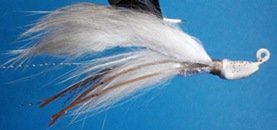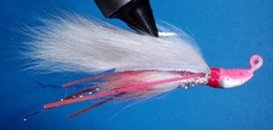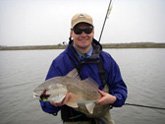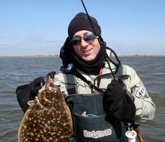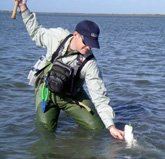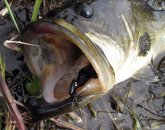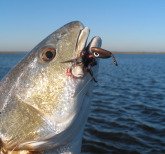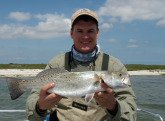Crazy Charlie Fly
The Crazy Charlie Fly is the most popular bonefish pattern of all time. It set the standard for the basic tying techniques for successful bonefish flies. Learn how to tie it and you'll be well on your way to a basic proficiency in flats patterns. There's an interesting story behind it as well. Read on to learn more and to find out how we used it as inspiration for the Loco Bugg from our Bonefish Collection.
The History
In the late 70's Bob Nauheim, owner of a Northern California fishing travel firm, traveled to the Bahamas on a bonefishing trip. He was fishing the flats of Andros Island with Charlie Smith, a pioneer and the first bonefishing lodge owner in the Bahamas. That day the bonefish were targeting glass minnows, and Charlie confirmed they were part of their regular diet.
Here's the rest of the story, straight from Bob, “That night, back in the lodge, I tied some flies with a bit of flash, some clear Mason 15 lb. mono, a couple of feathers, and a pair of bead eyes. The eyes were adopted from steelhead patterns I'd used with great success. It was the first time bead eyes were used on a bonefish pattern.”
“The next day we had a ball catching fish with the newly created pattern. Charlie said "dat fly is nasty mon", and that's when I gave it the name Nasty Charlie. I'd run into Lee Perkins, of Orvis fame, and he asked me about the fly design. He'd heard how effective it was on the flats. I sent him a sketch with tying instructions. Later that year it was presented in the Orvis Catalog as the "Crazy Charlie." It's had that name ever since. I"m delighted it's become such a widely accepted fly.”
The Construction
You read about the bead chain eyes above. That's the first and arguably the most important innovation of the Crazy Charlie Fly. This accomplishes two main things, both essential to most successful patterns. First, the fly will land hook point up, and sit upright on the bottom. Bonefish are constantly cruising the flats, and a lot of their attention is focused on the bottom and the critters that dwell there. Second, these bead chain eyes will give it a jigging action on the retrieve. This action fools fish the world over, freshwater and saltwater.
Then you have the body and the wing. Traditionally, the body of the Crazy Charlie Fly is tied by winding a flash material on the hook shank, and then winding a mono or other clear ribbing over the flash. You can also use diamond braid or other flashy materials. The wing, which is the part that extends up and out from the eyes, can be tied with natural materials like feathers, bucktail, or calf tail. It can also be tied with synthetic materials such as polar fibre or craft fur. My first choice, however, would be rabbit strips! While it will add some weight to the fly, the action and durability are unsurpassed!
These three examples of the Crazy Charlie Fly will give you an idea of the subtle differences mentioned above. The fly on the left is tied with a synthetic wing, krystal flash, and uses diamond braid for the body. The middle fly uses calf tail for the wing, which is a bit more durable than the synthetic wing but provides less movement in the water. The body uses the traditional clear mono ribbing over a flash body. Neither of these two flies have a tail. Lastly, the fly on the far right utilizes two effective variations. A small amount of flashabou tinsel is added at the tail, and grizzly saddle hackles are tied on each side to give it a barred appearance. Rarely in nature will you find anything monochrome.
So after the bead chain or heavier eyes, the body, and the wing, you have options that are only limited by your imagination! Tying in some tail materials and using multiple wing materials are just the beginning. Now you know the basics of tying the most popular bonefish fly of all time!
Scores of Imitations, Buggs Included!
Ever heard the saying, “Imitation is the sincerest form of flattery”? Well, it certain applies here! Pick up any fly catalog or search online for “bonefish flies” and you'll find scores of imitations of the Crazy Charlie Fly. The Gotcha Fly is one pattern that instantly comes to mind. And here at Buggs Fishing we were no different when we envisioned the first jig for our Bonefish Collection. You can see two examples below.
In honor of the Crazy Charlie Fly, we named our jig the Loco Bugg. The Buggs Bonefish Jig Head ensures that the jig lands hook point up. We wrap the body of the fly in diamond braid, and add a cross cut bunny tail with some subtle flash. And then we use a rabbit strip for the wing. To spice it up a little, we added hot tip crazy legs. To learn more about this jig, follow the link below.
Learn more about the Crazy Charlie inspired Loco Bugg. Link coming soon!
Conclusion – The Grammar of It
What's this, Heath, now you're giving us an English lesson? Nope, there's another definition of Grammar that I'm thinking of and I'll explain how it applies. Grammar: the elementary principles of a science or art. We think of it in terms of language, but as you can see it can apply to anything. The Crazy Charlie Fly is the grammar of bonefish fly and jig construction. Learn to tie it and how it works and you're off on the right foot. Many thanks to Bob Nauheim (February 9, 1934 – September 9, 2005), and may he rest in peace. We're thankful for his contributions to our sport.
Look for the Loco Bugg in the Buggs Fishing Store very soon!
We hope you've enjoyed the story of the Crazy Charlie Fly and hope you'll try it or a Loco Bugg on your next bonefishing adventure.
Home > Fly Tying Patterns > Crazy Charlie Fly




